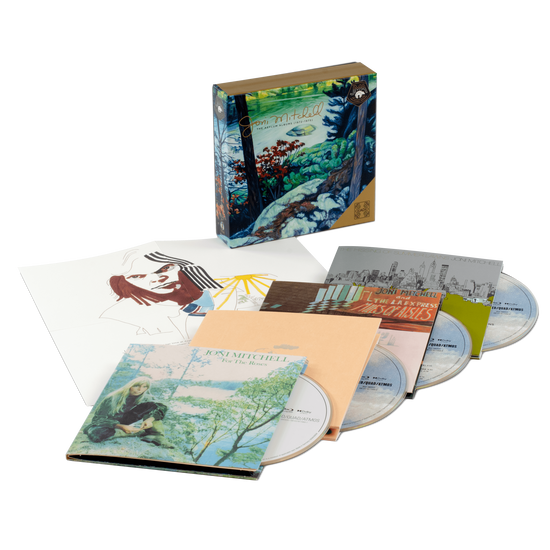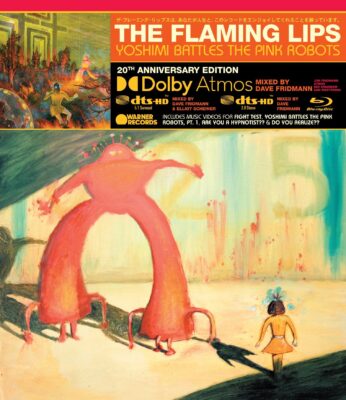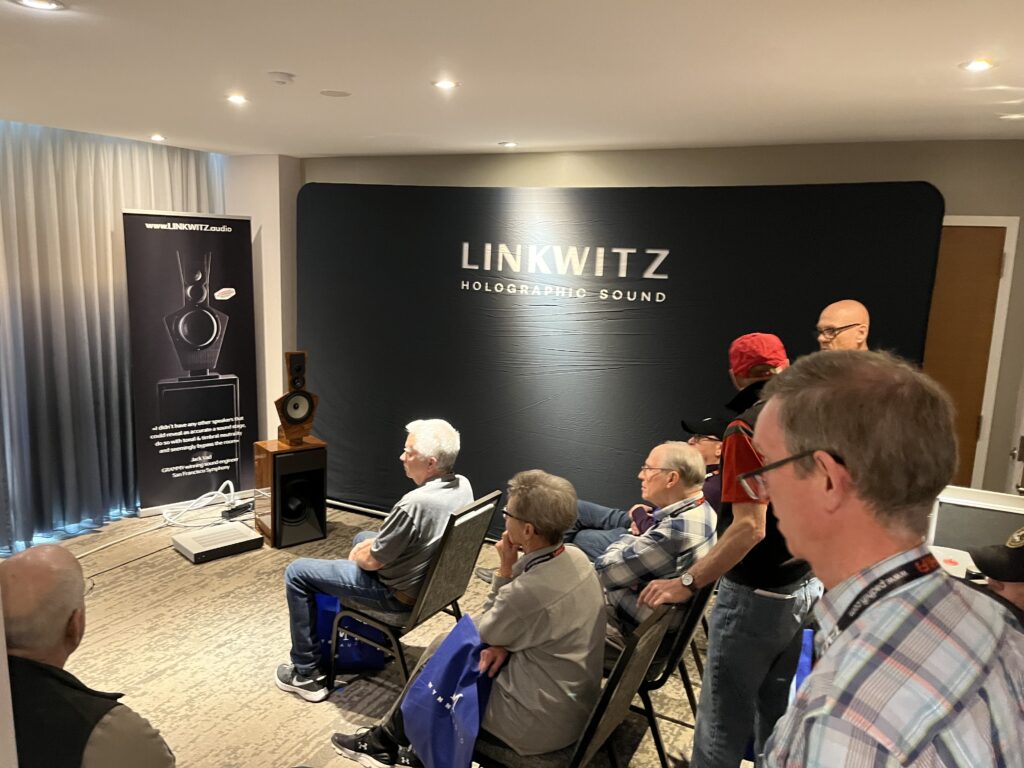
When the history of 20th Century American music is written at a sufficient remove from its creation and initial consumption, three white poet/songsmiths will figure prominently within a larger universe dominated by people of color. Bob Dylan will likely be designated the most influential but two Canadians will also have their champions. The late Leonard Cohen, respected as much for his written word output as for his darkly evocative songs, will loom large. And Roberta Joan “Joni” Mitchell, whose worldview developed in a small Saskatchewan town and matured in the cultural maelstrom of Los Angeles, is the literary equal of her two male colleagues and, many would say, a more accomplished musician. Rhino Records has been honoring the artist with their ongoing Joni Mitchell Archives project and has recently reissued her first four albums for Asylum Records on music-only Blu-ray discs that hold high-resolution stereo, quadraphonic, and Dolby Atmos mixes that demonstrate, perhaps for the first time, the potential for the last of these formats to reveal the full musical meaning of the best popular music.
The content of the four albums requires little comment other than to acknowledge the fecundity of Mitchell’s imagination, her probing stylistic adventurousness, and her gift for combining the highly personal with the universal—often with a uniquely female perspective—in songs that never seem dated. For the Roses (1972) followed the masterpiece Blue (1971) and continued to manifest Mitchell’s folk beginnings, even as she was moving towards the pop/rock spirit of Court and Spark (1973), her greatest commercial success with more than two million copies sold to date, and songs one can still encounter, unbidden, on a daily basis—“Help Me,” “Free Man in Paris,” “Raised on Robbery.” Rolling Stone magazine included Miles of Aisles (1974) in their list of the 50 best live albums. Tom Scott’s L.A. Express, which included players the songwriter frequently tapped for studio work, provided fresh, alert support for Mitchell, who demonstrates she’s a first-rate performer herself. The Hissing of Summer Lawns (1975) shows Joni edging ever-closer to a jazz esthetic.
The recordings were all originally engineered by Henry Lewy. They were released during the fleeting era of commercial four-channel sound, the late 1960s through the mid-70s, and two of the four, Court and Hissing, were issued as CD4 Quad LPs. Miles of Aisles was actually mixed for Quad but never released as such; that version sees the light of day here for the first time in 50 years. Bruce Botnick, best known for producing The Doors’ L.A. Woman, prepared a new four-channel mix of For the Roses. Rhino calls its high-resolution remasterings of quadraphonic originals “Quadio,” and that catalogue currently number about 20 albums, with artists ranging from Gil Evans to Randy Newman to Alice Cooper. The Atmos mixes for the Rhino set, prepared by Ken Caillat and Claus Trelby, are the audio option that will receive the most attention. Caillat, a half-century earlier, had been an assistant engineer for the Miles of Aisles recording and went on to co-found 5.1 Entertainment Group, a company specializing in multichannel mixing and mastering. Trelby has extensive spatial audio experience as well. It’s been reported that Joni Mitchell herself monitored their work and made occasional suggestions regarding this new treatment of her recordings from five decades previously.
Dolby Atmos, the most frequently encountered of the object-based, immersive codecs, has been problematic as a format for critical music listening. That’s because the bulk of available Atmos material is offered as streamed content (from Apple TV+, Amazon, and others) encoded as Dolby Digital Plus, which involves considerable data compression. In addition, the immersive mixes themselves have often been undistinguished—generic and predictable. Far more successful in faithfully serving musical ends has been The Dolby TrueHD format, which employs the Blu-ray disc as its platform. To this point, however, there have been only a few hundred programs of disc-based TrueHD content, little of it of great interest to general listeners. Until now.
With most of the material on the four albums, the Atmos option refines and clarifies the presentation of Mitchell’s art. Consider just one example, “In France They Kiss on Main Street,” the first song on The Hissing of Summer Lawns. Mitchell’s vocal is centrally focused and correctly scaled, and has been brought out in front of the plane of the speakers. The tonal quality of her voice is richly characterized as the singer effortlessly navigates from a silvery soprano—then, still entirely intact—to her earthier alto tessitura. The stellar group of musicians supporting Mitchell on the song included guitarists Jeff “Skunk” Baxter and Robben Ford, Victor Feldman on electric piano, bassist Max Bennett, drummer John Guerin, plus Graham Nash, David Crosby, and James Taylor contributing backup vocals (in addition to overdubbed Joni). The contribution of each is easily appreciated without artificial spotlighting, the organic whole they create utterly essential to the song’s joyous recollection of youthful carnality. An instance of “object-based” kind of spatiality comes partway through the first verse when Joni, over the listener’s left shoulder, enthusiastically inquires, “Do you want to dance?” The singer is surely part of this story, reliving her small-town past.
Significantly, all the formats offered on the discs are high resolution, so the set will appeal to Joni Mitchell aficionados who are strictly stereo listeners as well as to practitioners of traditional multichannel. If you’ve taken the Atmos plunge, it’s a no-brainer. If your system can do Atmos, it can, of course, also handle the stereo and four-channel versions. You’ve got a choice regarding the mix, a good thing as you may conclude that the Dolby TrueHD Atmos isn’t always the best one for a given song. The stereo mix can be preferable when it’s just Joni accompanying herself on piano or guitar. With the live album, I discovered that the Quadio option presented more of an on-stage perspective, which I thoroughly enjoyed, as opposed to the fifth row aural point of view that Atmos offered.
By the time you’re reading this, Rhino will have released the subsequent four Asylum albums that include Hejira, Don Juan’s Reckless Daughter, Mingus, and Mitchell’s second live album, Shadows and Light. These reissues will initially be available on both LP and compact disc; let’s hope that a Quadio/Atmos TrueHD version follows. For perhaps the first time, object-based immersive audio has been utilized by talented engineers with a deep appreciation for material that can only be described as “classic” to further elevate an already lofty musical experience.
Tags: MUSIC

By Andrew Quint
More articles from this editorRead Next From Blog
See all
An Immersive Masterpiece
- Jul 01, 2025

The Physics of Describing Music Reproduction
- Jun 10, 2025

Detailed Frequency Ranges of Instruments and Vocals
- Jun 05, 2025

















